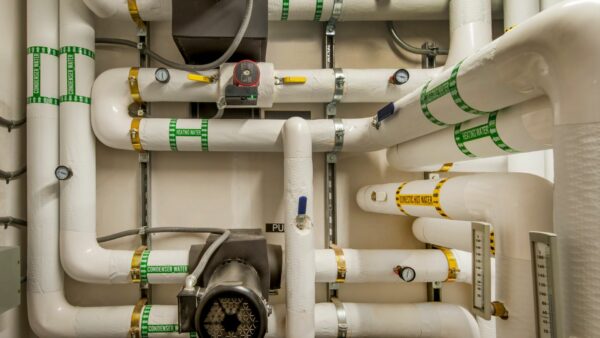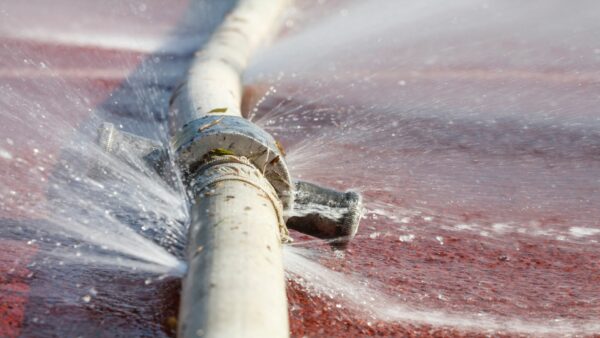Plumbing in towering high-rise buildings is like navigating a vertical maze of pipes and drains. Defined as structures over 75 feet tall, these giants pose unique challenges for plumbers who must ensure water flows smoothly up and down their many floors.
To tackle tasks from fixing faucets to designing drain systems that can withstand earthquakes, plumbers maneuver through complex pathways within the building’s skeleton.
With resident safety hanging in the balance alongside substantial maintenance bills—it’s clear: specialized skills make high-rise plumbing no job for amateurs. Step inside this high-stakes world where preventing problems before they start means everything operates efficiently day after day—without fail!
Key Takeaways
- High – rise plumbers face unique obstacles like ensuring consistent water pressure across floors, maintaining complex drainage systems, and ensuring easy access to pipes for repairs.
- Regular maintenance and using advanced technology are essential in high – rise plumbing to prevent emergencies and manage costs effectively.
- Collaboration with other experts such as architects and engineers is critical for designing safe, efficient plumbing systems that meet strict building codes.
- Professional high – rise plumbers must be adept in safety regulations, proper planning, coordination with property managers, and communication with residents for successful project execution.
- Implementing regular inspections of crucial components like elevators, structural integrity, fire-prevention systems, and emergency egress routes helps ensure the long-term functionality and safety of high-rise buildings.
Definition of a High Rise Building

A high-rise building towers above the landscape with multiple floors, typically considered to be taller than 75 feet or about seven stories. These buildings stand out due to their structural complexity and use of steel frames and glass exterior sheathing, important when considering the intricacies of plumbing systems within.
They rely heavily on elevators for vertical transportation – a key component given their height.
Constructing these giants requires robust foundations ready to bear immense gravity loads through concrete piers, piles, or caissons. High-rises not only change city skylines but also challenge engineers with lateral forces from winds and seismic activities.
The exteriors are often enclosed by curtain walls which don’t hold up the structure but must withstand elements like typhoons and hurricanes without transferring stress to residents inside.
Inside these structures are complex networks where commercial plumbing contractors play a crucial role in ensuring safety standards including fire prevention measures and secure evacuation routes for potentially thousands of occupants across mixed-used spaces – be it residential apartments, offices, retail outlets or hotels.
Challenges Faced by Plumbers in High Rise Buildings
Plumbers tasked with maintaining the complex systems of high-rise buildings encounter a unique set of obstacles, from intricate pipe networks to gravity-induced issues. These professionals must navigate the vertical labyrinth of utilities, ensuring every floor receives reliable and safe water services.
Accessibility to plumbing systems
Access to plumbing systems in high-rise apartment buildings poses unique challenges for commercial plumbing contractors. With the reliance on elevators for vertical transportation, navigating through a tower block can become time-consuming and logistically complex when handling bulky tools and equipment.
Contractors must plan strategically to transport materials and workers efficiently, often coordinating with building management to schedule elevator use during off-peak hours.
Effective access strategies are vital for timely maintenance and emergency repairs within these residential towers. Given that electric motors power elevators and are guided by tracks, outages or malfunctions could further exacerbate accessibility issues.
Plumbing professionals need to familiarize themselves with alternative methods of reaching critical systems during such scenarios. This preparedness ensures they provide consistent service regardless of external factors affecting the building’s primary means of vertical transport.
Special attention is given to designing accessible spaces around crucial plumbing infrastructure during construction phases of high-rise projects. This foresight significantly enhances efficiency when it comes time for inspections, routine upkeep, or addressing sudden issues that may arise in both mid-rise structures and soaring residential high-rises alike.
Keeping these considerations top-of-mind helps mitigate risks associated with maintaining the intricate network of pipes that serve as the lifeblood of any towering residential habitat.
Pressure and flow issues
While ensuring accessibility to plumbing systems in high-rise buildings, commercial plumbing contractors must also tackle the persistent problem of pressure and flow. Water supply lines stretching skyward face decreasing pressure with height, requiring sophisticated pumps and regulators to maintain a consistent flow throughout towering structures.
These mechanisms are crucial for delivering water to upper floors without compromising on performance or violating any building codes.
Addressing these issues demands meticulous planning and installation of pressurization systems that counteract gravity’s pull. Expert plumbers need to design such systems with precision, ensuring that all residential tower blocks receive an adequate water supply under varying conditions.
This is particularly challenging during peak usage times when the demand for water increases dramatically within apartment blocks. Skilled professionals adept at solving these complex problems can provide reliable solutions that meet the dynamic needs of modern high-rise living.
Complex drainage systems
Moving beyond pressure and flow concerns, high rise buildings present a particular challenge for plumbing with their intricate drainage systems. To handle the significant demands of vertical waste transport, these structures depend on expertly designed networks that swiftly move water and refuse from all levels without causing backups or damage.
Plumbers working in this environment must possess an intimate knowledge of advanced piping strategies to maintain system integrity. Mastery over these systems ensures that residents live comfortably and safe from the complications of poor drainage.
High-rise towers demand a higher standard in how they manage wastewater—a critical task that safeguards the well-being of countless occupants daily.
Importance of Proper Plumbing in High Rise Buildings

The integrity of a high-rise’s plumbing system is paramount, impacting not only the comfort and health of its occupants but also the longevity and safety of the structure itself, underscoring the need for expert attention to ensure these towering communities thrive above the cityscape.
Safety of residents
Ensuring the safety of residents in high-rise apartments and towers is a critical responsibility for plumbing contractors. High-rise buildings are equipped with elevators, often seen as the lifeblood for vertical movement within these structures, necessitating meticulous attention to fire-prevention standards and sufficient escape routes.
A well-designed plumbing system contributes significantly to these safety measures by managing water supply used during emergencies and maintaining proper drainage to prevent leaks that could compromise structural integrity.
Regular maintenance of plumbing systems in blocks of flats or residential high rise is not only about preventing inconvenience; it’s fundamentally about protecting occupants from potential hazards.
With an elevated understanding of lateral forces due to winds or earthquakes, professional plumbers must ensure their work withstands such stresses. Elevator shafts need safeguarding against flooding which can cause malfunctions or even failures in electric motors and tracks essential for the lift operations, directly impacting resident movement especially during evacuations.
Plumbers working on projects involving reinforced concrete structures like office towers or apartment towers have to be especially vigilant. These materials require specific knowledge regarding installation techniques that ensure water pipes do not weaken the building’s frame.
Moreover, strategies should be implemented cohesively within housing schemes so that all residents reap the benefits of secured plumbing infrastructure designed for their tall living spaces.
Maintenance and repair costs
Maintenance and repair expenses can quickly escalate in high-rise buildings if plumbing issues aren’t handled promptly. Given the complex nature of these structures, from high-rise blocks to sprawling midrises, maintenance challenges demand specialized knowledge and tools.
Efficiently resolving problems not only prevents damage but also minimizes downtime that could affect residents or commercial tenants.
Staying on top of regular upkeep for systems throughout a skyscraper is crucial. It helps avoid the rippling effects of plumbing failures which can lead to costly repairs down the line.
Contractors need to be vigilant in their approach—conducting thorough inspections and addressing even minor leaks before they become major concerns—protecting both safety standards required by the International Building Code and property owner’s investments.
Solutions for Tackling High Rise Plumbing Challenges

To effectively conquer the intricate obstacles presented by high-rise building plumbing, professionals tap into an array of solutions including state-of-the-art technologies and proactive preventative strategies that maintain system integrity and performance—discover how these innovative approaches can transform your high-rise plumbing projects.
Regular inspections and maintenance
Regular inspections and maintenance are the lifelines of high-rise building plumbing systems. They keep everything from water pressure to drainage running smoothly.
Prioritize elevator inspections: Ensure that vertical transportation systems are functioning efficiently for residents’ convenience and safety.
Examine structural integrity: Regularly check steel frames and glass sheathing to prevent deterioration that can compromise a building’s strength.
Assess foundation conditions: Conduct thorough evaluations to tackle any issues that could affect the ability of high-rises to bear heavy loads.
Monitor wind and seismic impacts: Stay vigilant about changes in lateral forces due to weather or earthquakes that might affect the building’s stability.
Inspect curtain walls frequently: Look out for damage on non-load-bearing walls made of materials like glass, masonry, stone, or metal to ensure longevity.
Keep fire-prevention measures updated: Maintain strict standards for fire safety by ensuring all components meet current codes and regulations.
Elevator functionality is crucial: Pay attention to elevators’ operational status, as they play a vital role in the daily life within highrise apartment buildings.
Regularly test emergency systems: Check smoke alarms, fire extinguishers, and evacuation protocols regularly to guarantee resident safety during emergencies.
Use of advanced technology
Plumbers tackling high-rise challenges turn to cutting-edge technology to ensure the entire plumbing system operates smoothly, from foundation to penthouse. Innovative vertical transportation systems like sophisticated elevator tech play a crucial role.
These aren’t just for moving people; they also support large scale movement of equipment and materials needed for maintenance and repairs. Advanced construction materials come into play as well, providing the structural integrity needed for handling heavy gravity loads in these towering structures.
Designing plumbing that stands up to lateral forces from winds or potential earthquakes takes advanced engineering technologies. Tailored solutions using state-of-the-art curtain wall systems help enclose high rises efficiently, protecting the intricate networks of pipes within.
Meanwhile, electric motors and track systems are not solely about elevators—they’re vital for maintaining critical water pressure levels across different floors.
Safety remains top priority in sky-high living spaces with elevated risks such as fire hazards requiring advanced prevention technologies and egress systems. These modern marvels align with guidelines set by the 2015 International Building Code—essential knowledge for plumbers who must navigate complex regulations while safeguarding residents’ comfort and security amidst bustling streets in the sky.
Collaborating with other professionals
Collaborating with other professionals is like assembling a team of experts, each bringing their specialized skills to tackle complex high-rise plumbing issues. Imagine working alongside architects who design towering structures that fill city skylines, or structural engineers who ensure these giants can stand tall against strong winds and earthquakes.
This multidisciplinary teamwork creates buildings that are not only visually stunning but also safe and functional for all occupants.
In the realm of high-rise construction, every detail counts—from ensuring adequate water pressure on the top floors to designing escape routes in case of emergencies. Mechanical engineers play a crucial role, integrating systems seamlessly within the skeleton of concrete and steel devised by their colleagues in architecture and engineering.
Fire-protection specialists join the effort as well, contributing their expertise to develop advanced safety features that meet strict international codes set by bodies like the International Code Council.
Together, this coalition diligently works behind the scenes so residents can enjoy life sky-high without giving a second thought to what’s happening within their walls.
Importance of Hiring a Professional Plumber for High Rise Buildings

The unique complexities of high-rise plumbing demand a professional plumber’s expertise to navigate issues that could otherwise go unnoticed. Entrusting these intricate systems to a seasoned expert not only ensures compliance with strict regulations but also secures the integrity and functionality of the building’s vital waterworks.
Expertise in dealing with complex systems
Tackling the plumbing of high-rise structures demands a deep understanding of their intricate frameworks. Expert plumbers must navigate the maze of pipes and fixtures spread across multiple floors with precision.
They face unique challenges such as ensuring stable water pressure at great heights, which involves a keen grasp on how gravity and building design affect fluid dynamics.
Handling these systems requires familiarity with advanced tools and diagnostics to detect issues before they escalate. A seasoned plumber can employ video inspection techniques to peer inside pipelines without invasive measures, identifying blockages or wear that could spell disaster in densely populated towers like jin mao tower or shanghai tower.
Mastery over complex plumbing networks also entails knowledge about up-to-date safety regulations and strategies for minimizing disruption during repair work.
Coordination plays a pivotal role in managing the vast plumbing requirements of colossal edifices such as central park tower or abraj al-bait. Professional plumbers must work closely not only with property managers but other contractors to ensure seamless operation from deck-access points to the highest condominiums—a symphony of expertise orchestrated to prevent costly damages and maintain habitability in soaring urban landscapes.
Knowledge of safety regulations and codes
Understanding complex systems is critical, but it’s just a piece of the high-rise plumbing puzzle. Mastering safety regulations and codes is equally crucial. These rules ensure that every inhabitant in towering structures has a safe environment.
Trained professionals know these guidelines inside out – from fire-prevention standards to precise measurements for adequate escape routes in emergencies.
Familiarity with the 2015 International Building Code can elevate your service quality; it’s an essential tool for navigating any job above 75 feet high where specific safety measures kick into gear.
Ensuring plumbing work aligns with these norms not only guarantees resident protection but also shields you from legal issues down the road.
Professional plumbers adept at interpreting and applying local and international codes bring unmatched value to their craft. They tackle challenging projects within high rises with confidence, making sure each step they take meets rigorous safety expectations.
This expertise translates into peace of mind for property managers who trust them with residents’ well-being day after day.
Proper planning and coordination with commercial property managers and residents.
Proper planning is the scaffolding of successful plumbing operations in high-rise settings. It’s crucial for professional plumbers to sync up with commercial property managers from the get-go.
Establishing a solid line of communication ensures that every layer of the building’s intricate plumbing system gets proper attention. This teamwork makes it possible to swiftly tackle emergencies and conduct routine maintenance without disrupting daily life for residents.
Coordination involves mapping out a strategy with all stakeholders, discussing timelines for inspections, repairs, and upgrades. Commercial property managers often have valuable insights into the building’s history and specific needs—information that can help you anticipate problems before they balloon into disasters.
Engaging residents early on also fosters trust; they depend on your expertise to keep their homes safe and functional. By working closely together, both planned projects and unexpected issues are handled efficiently, keeping everyone informed and satisfied with the process.
Conclusion
High-rise plumbing requires skill, precision, and a deep understanding of unique challenges. Plumbers in this field play a crucial role in ensuring the safety and comfort of countless residents.
With regular maintenance and the right professional knowledge, even the most complex systems can be managed efficiently. Employing advanced technology and collaborating closely with various professionals lead to innovative solutions for these towering tasks.
High-rise buildings stand as monuments to human ingenuity, but it’s the expertise of dedicated plumbers that keeps their lifeblood flowing smoothly day after day.
FAQs
1. What unique plumbing challenges do high rise buildings present?
High rise flats and towering blocks of flats, like the Chrysler Building or the Lotte World Tower, face complex plumbing issues such as maintaining water pressure and preventing vortices in pipes—a problem not often found in low-rise structures.
2. How can plumbers manage waste systems effectively in tall structures?
In skyscrapers such as Tianjin CTF Finance Centre or Canton Tower, implementing a well-designed MDUS (mechanical drainage under suction) system helps to efficiently handle wastewater and protect against cyclonic storms that could impact sewage systems.
3. Can historical building designs inform modern plumbing solutions for high-rises?
Yes, studying past successes like Park Hill’s ‘streets in the sky’ concept or Le Corbusier’s Unité d’Habitation design provides insights on managing utilities within large-scale residential complexes that can be adapted to today’s high-rise housing demands.
Find Reliable Contractors Using BidSource
Property managers can use BidSource to have our team find a commercial plumbing contractor ready to assist with your property maintenance and upkeep. Share your job details using the form below and our team will be in touch with a qualified contractor!job


